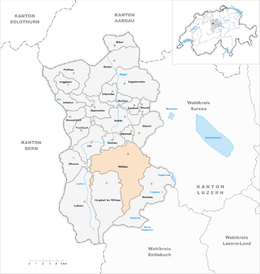Willisau
| Willisau | ||
|---|---|---|
 |
||
|
||
| Coordinates: 47°7′N 8°0′E / 47.117°N 8.000°ECoordinates: 47°7′N 8°0′E / 47.117°N 8.000°E | ||
| Country | Switzerland | |
| Canton | Lucerne | |
| District | Willisau | |
| Area | ||
| • Total | 41.11 km2 (15.87 sq mi) | |
| Elevation | 557 m (1,827 ft) | |
| Population (Dec 2015) | ||
| • Total | 7,676 | |
| • Density | 190/km2 (480/sq mi) | |
| Postal code | 6130 | |
| SFOS number | 1151 | |
| Surrounded by | Alberswil, Ettiswil, Gettnau, Grosswangen, Hergiswil bei Willisau, Luthern, Menznau, Ufhusen, Zell | |
| Website |
www Profile (German), SFSO statistics |
|
Willisau is a municipality in the district of Willisau in the Lucerne canton of Switzerland. It was formed on 1 January 2006 from the municipalities of Willisau Land (W. Country) and Willisau Stadt (W. Town).
During the 12th century AD the von Hasenburg family acquired Asuel in the Willisau area. The patronage rights of the Willisau church and the use of a bailiwick within the grand parish of Willisau provided for a substantial income. As privileged vassals and tax-collectors for the House of Habsburg the Hasenburgs' sphere of influence expanded, although they never were granted the title of count.
From spring 1302 to summer 1303, Markward, Heimo and Walter von Hasenburg created the town of Willisau. The existing village was cleared, and the new town counted 150 inhabitants. Possessing a town was a status symbol for the Hasenburgs. The administrative seat of the Hasenburgs was an elevated medieval castle at the base of the mountain, which was later destroyed in the time of the Battle of Sempach. Newer archaeological findings indicate that Willisau already exhibited urban characteristics before its formal foundation.
The town of Willisau developed at the end of the Middle Ages. The town was surrounded by arable land and its inhabitants included many craftsmen. Willisau became a crafts centre and commercial city during the 16th century, although a devastating fire in 1704 decimated its prosperity. It took pride in its location on the most direct route from Lucerne to Berne and western Switzerland.
Willisau had received market rights already in 1330. In the first four decades after the founding of town, the Habsburgs kept a firm rule. Among the descendants (1367–1407), living outward, the urban district had substantial liberties, which led to the emergence of an administrative upper class. The new national rule in Lucerne allowed for citizens of a town to return certain privileges and administrative authority, even if the competencies were noticed by the bailiff. Thus Willisau became appended to a smaller feudal dominion and under the rule of Lucerne it developed to an administrative centre of a relatively large territorial district.
...
Wikipedia



